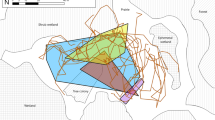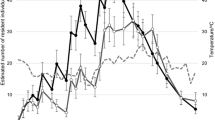Abstract
Mark resighting studies of the hornet robberfly, Asilus crabroniformis, were carried out during the flight seasons of 1999 and 2000 on agricultural land on the Chilterns in Oxfordshire, UK. Six patches of land were identified which contained characteristics thought to be attractive to hornet robberflies. One hundred and twenty eight adults were marked in 1999 and 257 in 2000. Marking was carried out on one of the patches, but resighting observations were collected from all six sites. The daily population sizes were estimated using the Jolly-Seber method. The daily population size peaked between 50 and 72 from 23 August until 13 September in 2000. This was very similar to the peak population size of between 50 and 74 estimated for 1999. Adults were found to be capable of living for nearly 5 weeks. The maximum linear distance from the point of marking that any individual moved across the study site was 625 m, but some individuals moved over 400 m in a single day. Unsuitable habitat (suburban gardens and a main road) did not present a barrier to dispersal. Males were more likely than females to loiter in sites peripheral to the breeding site, whilst females seemed to be more tied to the breeding site. Most adults were caught from dung piles, but insects avoided fresh dung and preferred instead dung that was well into the process of drying out. A variety of insect species were taken as prey, including many beetles and flies. The findings of the study are discussed in relation to the management of the landscape to enhance the long-term prospects of the hornet robberfly in the UK, and to achieve the UK Biodiversity Action Plan target for this species.
Similar content being viewed by others
References
Anholt B.R., Vorburger C. and Knaus P.2001. Mark-recapture estimates of daily survival rates of two damselflies (Coenagrion puella) and Ischnura elegans). Can. J. Zool.79: 895–899.
Anon1899. The larva of Asilus crabroniformis, L., destructive to that of Geotrupes. Ent. Mon. Mag.35: 116. [Translation of Xambeu, 1899].
Collett D.1994. Modelling Survival Data in Medical Research. Chapman and Hall, London.
DOE, 1995. Biodiversity: The Steering Group Report. HMSO, London.
Haddad N.M.1999. Corridor and distance effects on interpatch movements: a landscape experiment with butterflies. Ecol. Appl.9: 612–622.
Hanski I.1999. Metapopulation Ecology. Oxford University Press, Oxford.
Hardy P.B. and Dennis R.L.H.1999. The impact of urban development on butterflies within a city region. Biodiversity Conserv.8: 1261–1279.
Hill J.K., Thomas C.D. and Lewis O.T.1996. Effects of habitat patch size and isolation on dispersal by Hesperia comma butterflies: implications for metapopulation structure. J. Anim. Ecol.65: 725–735.
Holloway G.J. and McCaffery A.R.1990. Habitat utilization and dispersion in Eristalis pertinax (Diptera: Syrphidae). The Entomologist109: 116–124.
Holloway G.J., Griffiths G.H. and Richardson P.2003. Conservation strategy maps: a tool to facilitate biodiversity action planning illustrated using the heath fritillary butterfly. J. Appl. Ecol. (in press).
Hopkins G.W. and Day K.J.1997. The Southern Damselfly Coenagrion mercuriale: Dispersal and Adult Behaviour. CCW Contract Science Report 184. Countryside Council for Wales, Bangor.
Howe M.A.1997. The Status of the Hornet Robberfly Asilus crabroniformis in Gwynned and Monitoring of a Population at Pen-y-Bryn, Llanbedr in Merionethshire, 1992–1996, Natural Science Report 97/5/4. Countryside Council for Wales, Bangor.
King R.S.1998. Dispersal of Karner blue butterflies (Lycaeides melissa samuelis Nabokov) at Necedah national Wildlife Refuge. Trans. Wisconsin Acad. Sc. Arts. Lett.86: 101–110.
Knutson R.L., Kwilosz J.R. and Grundel R.1999. Movement patterns and population characteristics of the Karner blue butterfly (Lycaeides melissa samuelis) at Indiana Dunes National Lakeshore. Nat. Areas J.19: 109–120.
Kuussaari M.Saccheri I.Camara M. and Hanski I.1998. Allee effect and population dynamics in the Glanville fritillary butterfly. Oikos82: 384–392.
Lloyd D.2001. Dispersal Abilities and Population Structure of the Adult Hornet Robberfly Asilus crabroniformis at Caeau Bwlch SSSI, CCW Contract Science Report 458. Countryside Council for Wales, Bangor.
Majerus M.E.N.1994. Ladybirds. HarperCollins, London.
Skidmore P.1997. The Status of the Hornet Robberfly Asilus crabroniformis in South Wales, CCW Contract Science Report 212. Countryside Council for Wales, Bangor.
Smith M.N.2000. The Hornet Robberfly Asilus crabroniformis: Land Use and Livestock Grazing Regimes at Sites in England. English Nature Report Number 387. English Nature, Peterborough.
Smith M.N.2001. The current distribution of the hornet robberfly Asilus crabroniformis Linnaeus (Diptera, Asilidae) in England and Wales. Dipterists Digest8: 79–84.
Smolis M. and Grken B.1987. On the question of population size and intrapopulation mobility of diurnal butterflies with the example of Zygaenidae species (Lepidoptera, Zygaenidae) of a grassland. Dechaina140: 102–117.
Stubbs A.E. and Drake M.2001. British Soldierflies and their Allies, British Entomological and Natural History Society, Reading.
Sutcliffe O.L. and Thomas C.D.1996. Open corridors appear to facilitate dispersal by ringlet butterflies (Aphantopus hyperantus) between woodland clearings. Conserv. Biol.10: 1359–1365.
Sutcliffe O.L., Thomas C.D. and Peggie D.1997. Area-dependent migration by ringlet butterflies generates a mixture of patchy population and metapopulation attributes. Oecologia109: 229–234.
Sutherland W.J.1996. Ecological Census Techniques–A Handbook. Cambridge University Press, Cambridge.
Thomas J.A., Bourn N.A.D., Clarke R.T., Stewart K.E., Simcox D.J., Pearman G.S., Curtis R. and Goodger B.2001. The quality and isolation of habitat patches both determine where butterflies persist in fragmented landscapes. Proc. Roy. Soc. Lond B.268: 1791–1796.
Wahlberg N., Klemetti T., Selonen V. and Hanski I.2002. Metapopulation structures and movements in five species of checkerspot butterflies. Oecologia130: 33–43.
Xambeu V.1899. Moeurs & Métamorphoses de l'Asilus crabroniformis, Linné, (asile frolon.). Naturaliste13: 55–56.
Hanski I.Pakkala T.Kuussaari M. and Lei C.G.1995Metapopulation persistence of an endangered butterfly in a fragmented landscape. Oikos72: 21–28.
Author information
Authors and Affiliations
Corresponding author
Rights and permissions
About this article
Cite this article
Holloway, G.J., Dickson, J.D., Harris, P.W. et al. Dynamics and foraging behaviour of adult hornet robberflies, Asilus crabroniformis: implications for conservation management. Journal of Insect Conservation 7, 127–135 (2003). https://doi.org/10.1023/A:1027307619376
Issue Date:
DOI: https://doi.org/10.1023/A:1027307619376




